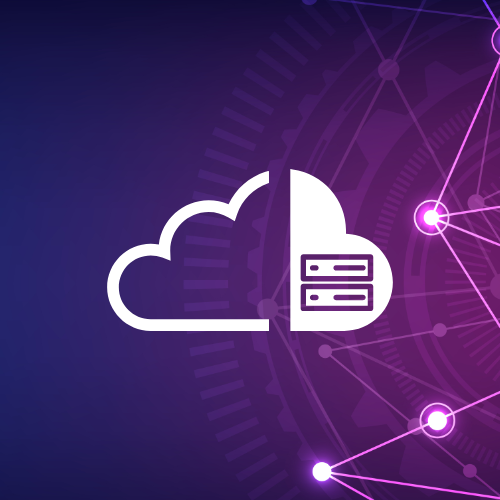Defining hybrid cloud
A hybrid cloud is a cloud computing environment using a mix of on-premises and off-premises, private and public cloud, and third-party cloud services. Important to note is an automated orchestration between the platforms. Hybrid cloud IT architecture enables organizations to achieve several goals, including:
- Networking multiple computers
- Consolidating IT resources
- Rapidly scaling out and provisioning new resources
- Moving workloads between environments
- Providing unified management
- Automating and orchestrating processes
Hybrid cloud environments share applications and data between an on-premises private cloud and a third-party public cloud. A flexible infrastructure between the two allows for an orchestrated blend of resources and increased flexibility.
Hybrid cloud architecture enables businesses to move workloads freely between the clouds as they see fit, select the ideal cloud for each, and cost-effectively meet business and technical objectives. Hybrid cloud computing also allows organizations to focus resources on their most sensitive data and applications. A frequent application is the use of public cloud storage to supplement internal storage.
How does it work?
There are two common hybrid cloud platforms — monocloud and multi-cloud. A hybrid monocloud strategy is a single hybrid cloud environment formed by extending one’s on-premises environment with a cloud provider’s software and hardware stack. The identical stack runs in both locations and users manage the tethered environments from the public cloud with the cloud provider’s management tools and infrastructure.
A hybrid multi-cloud uses an open standards-based or open-source stack. It can deploy across premises, multiple providers, and on any public cloud infrastructure. This means that although the on-premises and cloud environments are still tethered and form a single hybrid environment, users can manage the multi-cloud with the common set of management tools they choose, across multiple providers, on- or off-premises.
While some organizations may choose a monocloud approach, meeting their needs through a single vendor, most organizations demand the flexibility of a hybrid multi-cloud approach. More common still are businesses using a blend of cloud environments and microservices to move applications or components of applications across multiple services and vendors.
Benefits of the hybrid cloud approach
Hybrid cloud solutions bring many advantages to the table, including:
Scalability and resilience
Workload traffic spikes can be unpredictable, and even predictable spikes demand manageable and affordable capacity. A hybrid cloud strategy allows an organization to detect a surge and scale up using infrastructure quickly, cheaply, and automatically. When the peak has passed, the team can scale down without affecting other workloads on the private cloud.
Security and compliance
Hybrid cloud solutions enable organizations to retain the private cloud for deploying sensitive or highly regulated workloads, while the public cloud for those less sensitive.
Resource optimization and cost saving
The hybrid cloud environment provides IT with increased flexibility and more options for maximizing infrastructure budget and resources as they deploy workloads. It also offers more responsiveness to new opportunities and changing workloads. For example:
- Develop a division of labor for maintaining applications and workloads to reduce cost.
- Use on-demand public cloud resources for R&D or testing without affecting on-premises infrastructure.
- Quickly adopt tools, services, or products to streamline development or gain a business advantage.
- Free up teams to focus time and efforts on more important projects.
Key use cases
Data and AI integration
Organizations can quickly integrate data from new sources on the public cloud with existing data and analytics, AI capabilities, and machine learning to create more personal, smarter experiences.
Enhancing legacy systems
Looking to move from on-premises, some businesses use public cloud services to deploy resources globally to new devices and upgrade the user experience. For example, cloud application programming interfaces (APIs) are enhancing interoperability between clouds, leading to a boom in cloud application development.
SaaS integration
Hybrid cloud integration enables organizations to connect software-as-a-service (SaaS) applications on the public cloud to existing applications on public and private cloud, and traditional IT. This lets the team collaborate more closely and deliver new innovations.
VM migration
As organizations seek to scale and reduce the footprint of their on-premises data centers, a common approach is moving toward virtual machines (VM) and virtualized workloads on the public cloud.
Druva for hybrid cloud backup and data protection
A hybrid, multi-cloud world is the new reality. While many companies seek to migrate from on-premises to multi-cloud environments, they’re faced with a series of complex and challenging barriers to their cloud journey. A fundamental issue is the need for application and data protection. The ability to protect and recover business-critical data across multi-cloud environments with efficiency and speed is key to business resilience in the era of ransomware. Organizations need a single cloud-native platform to help scale resources and accelerate their leap to the cloud.
The Druva Data Resiliency Cloud, built on AWS, delivers cloud data protection and management across endpoints, data centers, and cloud workloads. Delivered as-a-service, Druva provides centralized management and a consolidated view of data that enterprises need to improve cyber resiliency, streamline governance, and gain critical insights to uncover opportunities and expedite decision making.
Visit the Druva website to learn more about how we accelerate and protect multi-cloud deployments, providing security and cost efficiency, while expanding the impact of your cloud journey across all stages. And watch the video below to explore Druva further.

